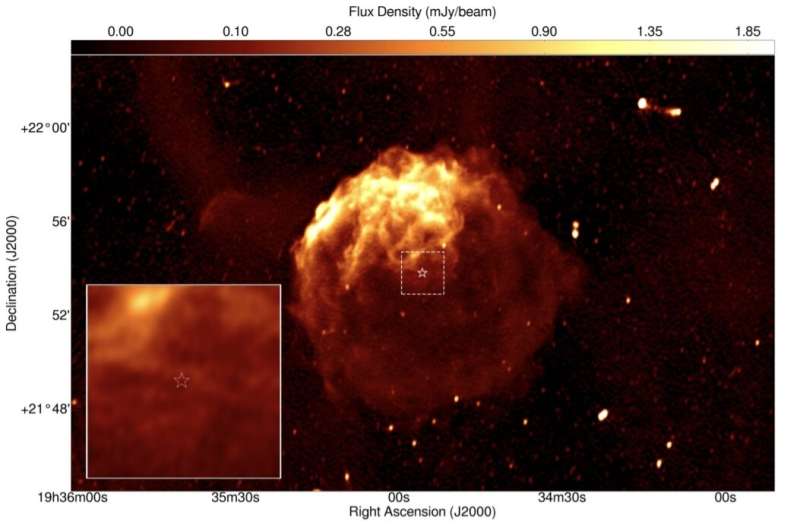March 16, 2021 report
Magnetar SGR J1935+2154 investigated in detail

Using various ground-based facilities worldwide, an international team of astronomers has carried out long-term multi-frequency radio observations of a galactic magnetar known as SGR J1935+2154. Results of the observational campaign, published March 10 on arXiv.org, shed more light on the properties of radio emission from this source.
Magnetars are neutron stars with extremely strong magnetic fields, more than quadrillion times stronger than the magnetic field of our planet. Decay of magnetic fields in magnetars powers the emission of high-energy electromagnetic radiation, for instance, in the form of X-rays or radio waves.
The Soft Gamma-ray Repeater (SGR) J1935+2154 was initially detected by the Burst Alert Telescope onboard NASA's Swift spacecraft, as an X-ray burst in July 2014. Subsequent observations of this source allowed the astronomers to classify it as a magnetar and they found that the source became active again in April 2020, when it exhibited multiple bursts.
On April 28, 2020, a very bright radio outburst of SGR J1935+2154 was identified that turned out to be brighter than any radio burst seen from any galactic source to date. Moreover, the corresponding energy of this outburst was estimated to be between one and two orders of magnitude less than the equivalent energy for the faintest fast radio bursts (FRBs).
FRBs are intense bursts of radio emission lasting milliseconds and showcasing the characteristic dispersion sweep of radio pulsars. The physical nature of these bursts is unknown, and astronomers have considered a variety of explanations, including synchrotron maser emission from young magnetars in supernova remnants, and cosmic string cusps.
In order to verify if SGR J1935+2154 and other magnetars could be the origin of FRBs, a group of researchers led by Benjamin Stappers of the University of Manchester, conducted multi-frequency radio observations of this magnetar. For this purpose, they used facilities including Arecibo Observatory, the Effelsberg 100-m Telescope and the Low Frequency Array (LOFAR).
"Magnetars are a promising candidate for the origin of FRBs. The detection of an extremely luminous radio burst from the galactic magnetar SGR J1935+2154 on 2020 April 28 added credence to this hypothesis. We report on simultaneous and non-simultaneous observing campaigns using the Arecibo, Effelsberg, LOFAR, MeerKAT, MK2 and Northern Cross radio telescopes and the MeerLICHT optical telescope in the days and months after the April 28 event," the team wrote in the paper.
According to the research, the range of pulse energies at which single-pulse emission has been detected from SGR J1935+2154 and the apparently brief time scales indicate that the source is exceptionally variable. The astronomers added that this variability is relatively high when compared to other magnetars in the Milky Way.
The observations failed to detect any significant single radio pulses down to fluence limits between 25 mJy ms and 18 Jy ms. Moreover, no point-like persistent or transient emission was identified at the location of the magnetar, and also no optical emission was detected during the observational campaign.
SGR J1935+2154 has a dispersion measure (DM) of about 333 pc/cm3 and is estimated to be located most likely some 21,000 light years away. Taking into account these parameters, together with the findings regarding emission from SGR J1935+2154, the astronomers draw conclusions on the possible link of this magnetar with FRBs.
"The optical observations of the field combined with the DM of the magnetar allowed us to obtain a distance estimate for the magnetar, which supports a closer distance. This would suggest that the FRB-like burst might be a factor of two or more less luminous than previously thought and thus about two orders of magnitude fainter than the least luminous of the known extragalactic FRB pulses," the researchers concluded.
More information: Multi-frequency observations of SGR J1935+2154, arXiv:2103.06052 [astro-ph.HE] arxiv.org/abs/2103.06052
© 2021 Science X Network





















